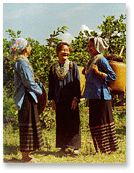Home » Ethnic People » Bahnar
The Bahnar (or Ba-Na) People

Bahnar people trace their ancestry back many centuries to communities co-existing on the coastal plains with the Cham and Jarai. Now the Bahnar minority, numbering some 140,000, mostly live in the highlands east of Plei Ku and Kon Tum.
The most distinctive aspect of a Bahnar village is its rong or communal house, the roof of which may be up to 30m high and slightly curved. The rong is the centre of village cultural and ceremonial life, and also the home of adolescent boys, who are taught Bahnar history, the skills of hunting and other manly matters. The village houses grouped around the rong are typically stilt houses with a thatched or tiled roof, and are often decorated with geometric motifs.
For centuries Bahnar people have traded with the Cham and later the Viet people of the low lands, and as a result, have a little tradition of handicrafts. However they are well-known for their animal husbandry and horticulture, growing maize, sweet potato or millet, together with indigo, hemp or tobacco as cash crops. Bahnar groups also erect funeral houses and decorate them with elaborate carvings, though they are not as imposing as those of the Jarai. Sometime after the burial, wooden statues, gongs, wine jars and other items of family property will be placed in the funeral house.
They are animists and worship trees such as the banyan and ficus. The Bahnar keep their own traditional calendar, which calls for 10 months of cultivation, the remaining two months set aside for social and personal duties such as marriage, weaving, buying and selling of food and wares, ceremonies and festivals. Traditionally, when babies reached one month of age, a ceremony was held in which, after their ears were blown into, the ear lobes were pierced, thus making the child officially a member of the village. Those who died without such holes were believed to be taken to a land of monkeys by a black-eared goddess called Duydai.
With extracts from The Rough Guide to Vietnam by C Jan Dodd

